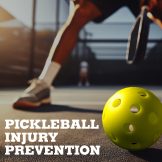
Pickleball is one of the fastest-growing sports in the United States, attracting players of all ages and fitness levels. Combining elements of tennis, badminton, and ping-pong, pickleball offers a fun and engaging way to stay active. However, as with any physical activity, it’s essential to prioritize injury prevention and incorporate proper stretching techniques to maintain optimal orthopedic health. Whether you are new to pickleball or are already an experienced player, Midwest Orthopedic Specialty Hospital (MOSH) is committed to helping you stay in the game, pain-free. Here’s a comprehensive guide to pickleball stretches and injury prevention.
The Popularity and Health Benefits of Pickleball
Pickleball has gained popularity due to its accessibility and health benefits. It’s a low-impact sport that improves cardiovascular health, enhances coordination, and strengthens muscles. The social aspect of the game also boosts mental well-being. However, the quick lateral movements, abrupt changes in direction, and repetitive motions that come with pickleball can lead to injuries if proper precautions are not taken.
Common Injuries in Pickleball
Understanding the common injuries associated with pickleball can help you take proactive steps to prevent them. Here are some typical injuries and how they occur:
Sprains and Strains
- Sprains involve overstretching or tearing ligaments, commonly in the ankles.
- Strains involve overstretching or tearing muscles or tendons, often in the hamstrings or lower back.
Tendonitis
- Overuse of certain muscles and tendons—especially in the shoulders, elbows, and wrists—can lead to inflammation and pain known as tendonitis.
Knee Injuries
- Quick pivots and sudden stops can stress the ligaments and cartilage in the knees, leading to conditions like patellar tendinitis or meniscus tears.
Rotator Cuff Injuries
- The repetitive overhead movements can cause wear and tear on the rotator cuff tendons in the shoulder, leading to pain and reduced range of motion.
The Importance of Stretching for Injury Prevention
Stretching is crucial for preventing injuries and enhancing performance. It increases flexibility, improves range of motion, and prepares the muscles for the physical aspects of pickleball. Here’s a look at different types of stretching and their benefits:
Dynamic Stretching
- Involves moving parts of your body through a full range of motion in a controlled manner.
- Best done BEFORE playing to increase blood flow and muscle temperature.
Static Stretching
- Involves holding a stretch for 15-60 seconds to elongate the muscle.
- Best done AFTER playing to relax muscles and improve flexibility.
Essential Stretches for Pickleball Players
Incorporate these stretches into your routine to keep your muscles flexible and reduce the risk of injury:
Pre-Game Dynamic Stretches
- Arm Circles
- Stand with your feet shoulder-width apart.
- Extend your arms out to the sides and make small circles, gradually increasing in size.
- Do this for 30 seconds in each direction.
- Leg Swings
- Stand next to a wall or support.
- Swing one leg forward and backward, gradually increasing the range of motion.
- Do 15-20 swings on each leg.
- Torso Twists
- Stand with your feet shoulder-width apart and arms outstretched.
- Twist your torso to the right, then to the left, in a controlled motion.
- Repeat for 30 seconds.
Post-Game Static Stretches
- Hamstring Stretch
- Sit on the ground with one leg extended and the other bent inward.
- Reach for the toes of the extended leg, keeping your back straight.
- Hold for 30 seconds and switch legs.
- Quad Stretch
- Stand on one leg and pull the opposite foot toward your buttocks.
- Keep your knees close together and hold for 30 seconds.
- Switch legs.
- Shoulder Stretch
- Bring one arm across your body and hold it with the opposite arm.
- Hold for 30 seconds and switch arms.
Strengthening Exercises for Pickleball Players
Strengthening the muscles used in pickleball can further reduce injury risk. Here are some exercises to incorporate into your routine:
Resistance Band Exercises
- Shoulder External Rotation
- Attach a resistance band to a stable surface.
- Hold the band with your elbow bent at 90 degrees and pull outward.
- Do 3 sets of 10-15 repetitions on each arm.
- Lateral Band Walks
- Place a resistance band around your thighs.
- Step sideways, keeping tension on the band.
- Do 3 sets of 10-15 steps in each direction.
Core Strengthening
- Planks
- Hold a plank position with your elbows on the ground and body in a straight line.
- Hold for 30-60 seconds, gradually increasing the duration as you get stronger.
- Russian Twists
- Sit on the ground with your knees bent and feet off the floor.
- Hold a weight or medicine ball and twist your torso to the right, then to the left.
- Do 3 sets of 15-20 repetitions.
Tips for Injury Prevention
In addition to stretching and strengthening, consider these tips to prevent injuries
Warm-Up and Cool Down
- Always warm up before playing to prepare your body and cool down afterward to aid recovery.
Stay Hydrated
- Dehydration can lead to muscle cramps and decreased performance. Drink plenty of water before, during, and after playing.
Warm-Up and Cool Down
- Wear supportive shoes designed for court sports and use a paddle that suits your grip and playing style.
Warm-Up and Cool Down
- Pay attention to any pain or discomfort. Rest and seek medical attention if needed to prevent minor issues from becoming serious injuries.
Supporting Your Game and Orthopedic Health
Pickleball is a fantastic way to stay active and have fun, but it’s important to take steps to prevent injuries. By incorporating proper stretches, strengthening exercises, and following injury prevention tips, you can enjoy the game while maintaining your orthopedic health. At MOSH, we’re here to support you. If you have any concerns or experience any pain while playing, don’t hesitate to reach out to our team of orthopedic specialists. Schedule an appointment today and let us help you stay in the game, pain-free.